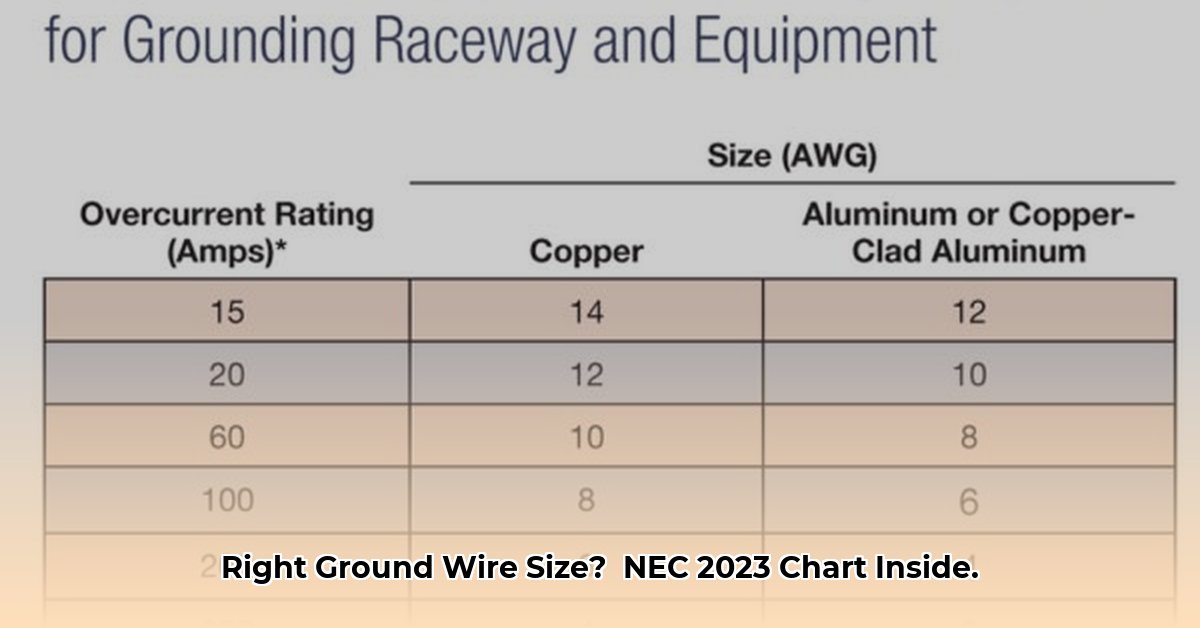Ensuring electrical safety in your home begins with proper grounding. This guide, based on the NEC 2023, provides clear instructions on how to select the correct ground wire size for various applications.
Quick Grounding Essentials
Proper grounding is crucial for electrical safety. It channels stray currents away, preventing shocks, fires, and appliance damage. Selecting the correct ground wire size, as outlined in NEC Table 250.66, is paramount for effective grounding.
Why Ground Wire Size Matters
Wire size directly relates to its current-carrying capacity. Just as a larger pipe carries more water, a thicker wire safely conducts more electricity. Using an undersized ground wire risks system failure and potential hazards.
Decoding NEC Table 250.66
NEC Table 250.66 dictates the required ground wire size based on your service entrance conductors (main power cables). Factors influencing sizing include the wire’s ampacity (maximum safe current) and material (copper or aluminum).
Simplified Ground Wire Size Chart (Copper Conductors)
This simplified chart, for common residential copper conductor applications, offers a quick reference. Consult the full NEC Table 250.66 for all applications to ensure compliance.
| Ungrounded Conductor Size (AWG) | Grounding Conductor Size (AWG) |
|---|---|
| 14 | 14 |
| 12 | 12 |
| 10 | 10 |
| 8 | 8 |
| 6 | 6 |
| 4 | 8 |
| 3 | 8 |
| 2 | 8 |
| 1 | 6 |
| 1/0 | 4 |
| 2/0 | 4 |
| 3/0 | 4 |
| 4/0 | 2 |
Important: This simplified table is for quick reference only. Always verify with the complete NEC Table 250.66 for all applications.
Using NEC Table 250.66: A Step-by-Step Guide
-
Identify Ungrounded Conductor: Locate the size (AWG) and material (CU for copper, AL for aluminum) of your service entrance conductors, usually marked in your main electrical panel.
-
Find the Corresponding Row: In NEC Table 250.66, find the row matching your ungrounded conductor size and material.
-
Locate Grounding Conductor Column: Identify the correct column (copper or aluminum) for your grounding conductor.
-
Determine Correct Size: The value at the intersection of the row and column is your required ground wire size. Double-check for accuracy.
Copper vs. Aluminum Conductors
Copper, with higher conductivity, requires a smaller gauge than aluminum for the same current. Aluminum, though less conductive, offers cost savings, particularly for larger installations. The NEC accounts for these differences in its sizing recommendations.
Understanding AWG and kcmil
AWG (American Wire Gauge) measures wire diameter. Smaller AWG numbers denote thicker wires with higher ampacity. kcmil (thousand circular mils) measures wire area, typically for larger conductors.
Common Grounding Misconceptions
A common misconception is that ground and hot wires must be the same size. This is incorrect. NEC Table 250.66 dictates grounding conductor size based on the ungrounded service conductor, not the hot wire.
Equipment Grounding Conductors (EGCs)
In addition to the main grounding conductor, equipment grounding conductors (EGCs) protect individual appliances and devices. NEC Table 250.122 specifies EGC sizing based on the circuit breaker rating.
Appliance-Specific Considerations
Appliances like ovens and water heaters may have specific grounding requirements. Always consult the manufacturer’s instructions and cross-reference with the NEC.
The 80% Rule for Continuous Loads
For loads operating continuously for 3 hours or more, the NEC recommends sizing the ground wire for 80% of the continuous load to prevent overheating.
Temperature Considerations
Higher ambient temperatures reduce a wire’s ampacity. Account for environmental factors when sizing ground wires, especially in hot locations.
Grounding vs. Bonding
Grounding connects the electrical system to earth, while bonding connects metallic parts of the system. These distinct concepts are crucial for overall safety.
Staying Up-to-Date
The NEC is periodically revised. Consult the latest edition and local amendments for the most current information.
Professional Consultation Recommended
While this guide provides valuable information, consult a qualified electrician for any electrical project. Their expertise ensures safety and code compliance. They can also address local code variations and specific application needs.
Further Resources
- National Electrical Code (NEC)
- National Fire Protection Association (NFPA)
Disclaimer: This information is for informational purposes only and does not constitute professional electrical advice. Always consult with a qualified electrician for any electrical work. Improper grounding can be dangerous. Safety is your responsibility.
- Greenhouse Storage Shed Combos: Your Guide to Combining Growing and Storage - April 21, 2025
- Greenhouse Shed Combo: Design, Build & Grow Year-Round - April 21, 2025
- Gingham vs. Plaid: What’s the Difference? A Complete Guide - April 21, 2025










